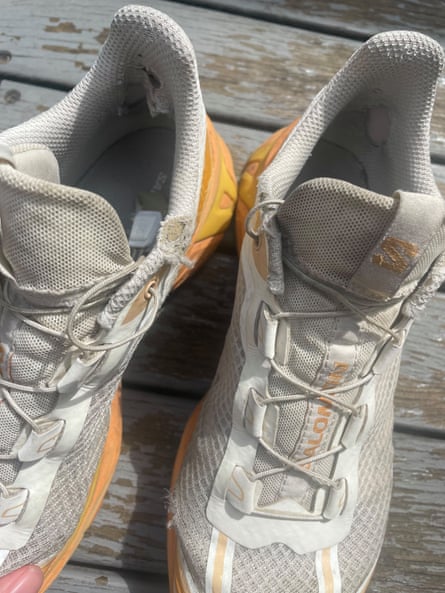
Earlier this year, at the beginning of a long work trip, I bought a new pair of sneakers. I wanted them to mark the professional win the trip represented and I knew I was going to wear them a lot. They were expensive, I paid about $330 for them, but they were worth it. I ran in them, walked long distances and wore them to important meetings with suits and dresses.
When I returned home after six months of travel, they looked tired. The mesh at the balls of my feet had worn through, the outer had some superficial scratches and they were torn around my ankles and inside at the back of the heels. Plus, they were discoloured and starting to smell. But I didn’t want to let them go.
Almost everyone I know has a pile of old grey sneakers in a corner of their cupboard, laundry or garage. They are easy to accumulate and difficult to throw away. Every year 25 million sneakers are imported into Australia. Because they are made of a mixture of plastic, fabric, leather and glue they are almost impossible to recycle. And they take around a millennium to biodegrade, so essentially every pair of sneakers ever made is still hanging around somewhere.
I decided to take this pair to a professional sneaker cleaner and restorer, hoping they could be freshened up. There are several sneaker laundries or spas in most Australian capital cities, and some mail-in businesses that service the entire country, all offering sneaker-specific care. I chose Sneaker Spa Sydney because they offer cleaning in addition to tear repair and paint touch ups.
When I dropped the sneakers off and had the prices explained to me, I realised I had to adjust my expectations. To have the major tears repaired, the scratches retouched and the shoes premium-cleaned would cost $230. Despite my belief in the importance of investing in the repair economy and the value of their skills, I couldn’t quite justify the expense. I decided not to have the scratches repainted, which reduced the total to $130.
The owner of the store, Sam Zacharia, explained to me that this type of sneaker is particularly difficult to clean. The mesh on the sides has a triple layer, so returning them to their original brightness requires re-dyeing – a service they offer, but at an additional cost. The clean is further complicated because the laces on this sneaker can’t be removed, which makes it harder to access certain parts of the shoes. He said generally, they get the best results on leather rather than plastic sneakers like mine.
after newsletter promotion
That leather is easier to repair doesn’t surprise me. I have several pairs of leather shoes that have been refurbished beautifully over the course of a decade, but I like sneakers to be really light which means I’m usually drawn to mesh and PVC. The next time I’m sneaker shopping I’ll keep Zacharia’s advice in mind for repairability and look for a more simple construction that uses less plastic, without being too heavy.
The clean took about a week. When I collected them, the results surprised me. Although I opted out of some repairs, the sneakers had a freshness that was definitely missing before.
The work done to fix the inside is impressive. The big holes behind my heels have been filled in with a foam composite and patched over with a piece of leather that’s been sewn neatly into the heel. The holes on the side of the mesh have been closed over with a mix of glue and baking soda that feels hard against my fingers, but Zacharia says, will soften as it wears.
When I look closely the mesh repairs are a bit crude, but from a distance, the surface is smooth and even. The holes around my ankle have also been closed with glue and while they’re not perfect, they definitely make the sneakers look good enough to wear them to meetings and out for dinner again.
Zacharia reminds me that with a bit more work everything else can be fixed, but sometimes a thorough clean is all it takes. “See how they come up and then go from there,” he says.


